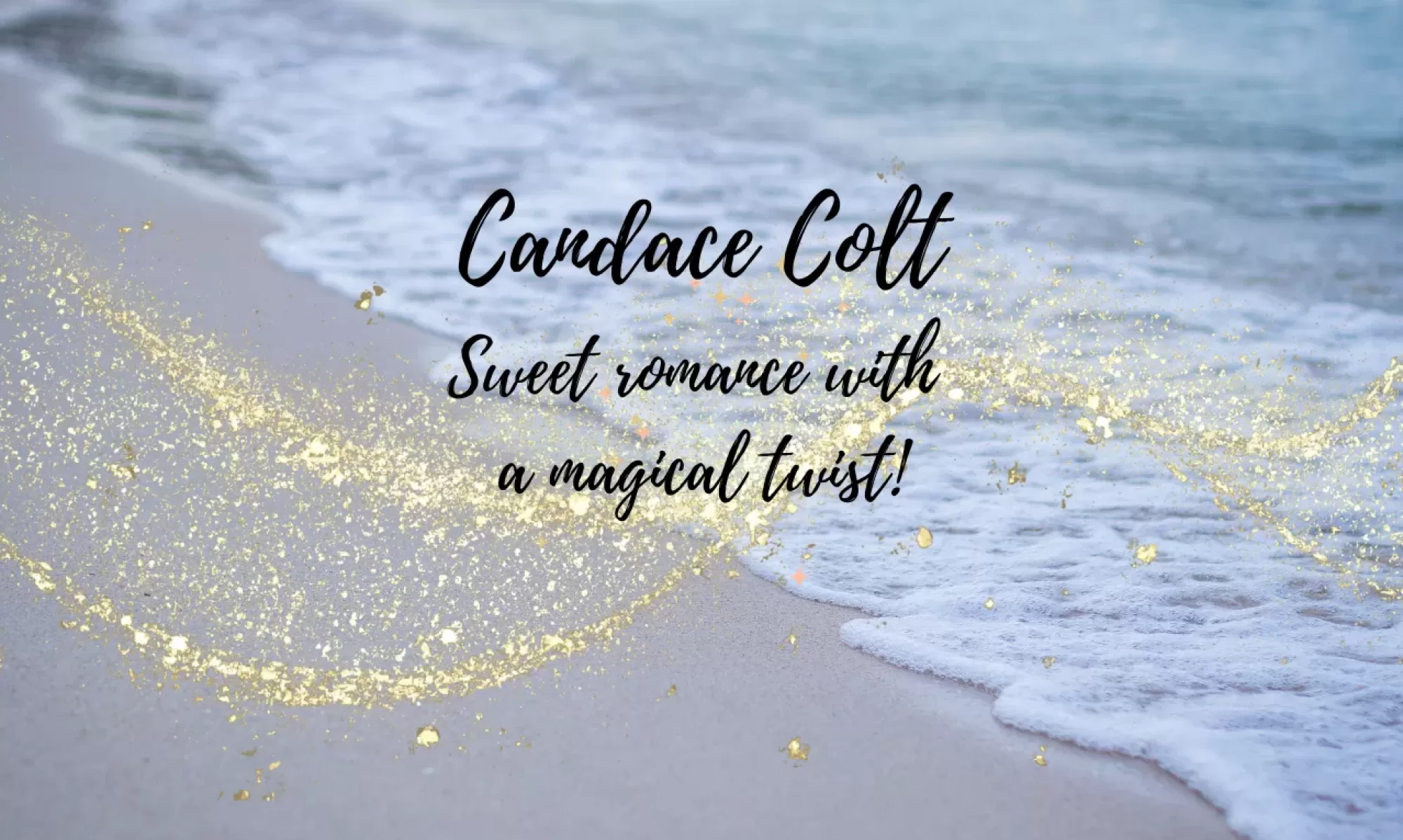(title apologies to Wm. Shakespeare)
Ryan Ford is the hero in my Nocturne Falls Universe paranormal novella, “The Falcon Finds His Mate.“ Oh. I should mention Ryan is a shape-shifting Peregrine falcon–one of the fastest birds on Earth.
Though the shape-shifters in my story are imaginary, falcons are real!
I’ve fallen in love with these creatures. Until I researched falcons for this story, I had no idea there were different members of this family.
In one scene, Ryan–in human form, is a contestant in a charity benefit for the local animal sanctuary and models with a North American Kestrel Falcon on his gloved hand.
Ryan chose the small and mighty Kestrel, because anything larger might frighten the unsuspecting humans in the audience. (Hey, it’s fiction–remember?)
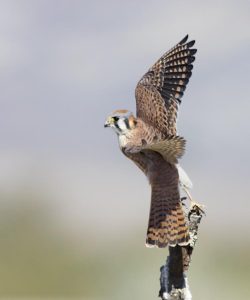
Sometimes called a sparrow hawk, the adult Kestrel weighs between 5-6 ounces; the approximate size of a mourning dove or a robin. The female is slightly larger than the male.
Though their larger cousins like Ryan (the Peregrine Falcon shifter) are faster, these little ‘race cars of the sky’ hold their own. Long wings and tail allow them to maneuver and kite in the air, and fly at speeds of up to thirty-nine miles per hour.
This photo is an adult female. Note her rust-colored wings and back. Her tale bands are narrower than the male. Those distinctive ‘sideburns’ and ‘mustache’ are found in both the female and male. If you look closely at the nape of her neck, you’ll see two dark patches that resemble eyes. These are thought to be deterrents to a predator approaching from behind. These faux eyes appear on both the male and female. (Photo courtesy Chris Mayne)
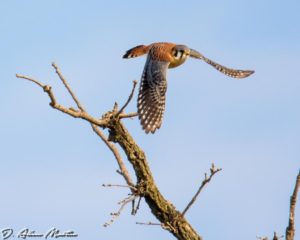
Speaking of sight, the Kestrel has incredible vision. They see in the UV light range so they can track prey at night, though they do most of their hunting during the day. Their coloration is camouflage for their own survival and for confusing their prey. (Photo courtesy D. Allen Martin)
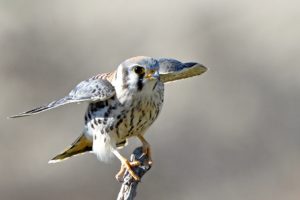
The adult male has slate-blue on the head and wings, but when perched, a black-spotted rusty mantle and scapulars predominate.
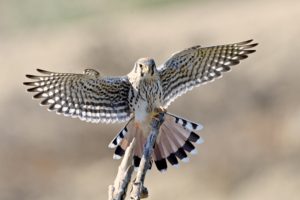 Depending on the gender, the adult wingspan can be up to 24 inches. The photo to the right is a male. Note the large dark band at the tip of his tale feathers.
Depending on the gender, the adult wingspan can be up to 24 inches. The photo to the right is a male. Note the large dark band at the tip of his tale feathers.
Though they can spot prey from a perch, Kestrels prefer to hunt by hovering over the ground then swooping down when they see a tasty target, moving so fast their prey doesn’t see them coming.
Ready for your quiz?
Male or Female?
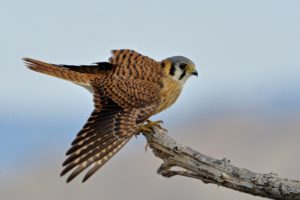
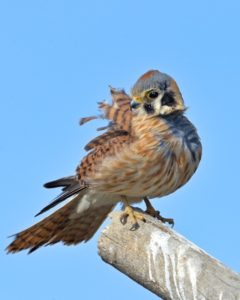
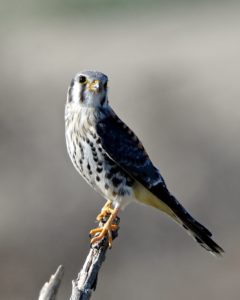
#1 = Female #2 = Female #3 = Male
(The above six photos courtesy Gerald Friesen)
The Kestrel’s yummy gourmet menu includes lizards, insects, snakes, rodents and small birds.
And eat like a bird? I wish! Kestrels eat up to 21% of their body weight each day. If I did that I’d have to consume…well, you don’t need to know everything!
They store food they don’t need in crevices in trees, utility pole boxes, rocks; wherever they can. Never know when you’ll need a quick bite when you’re out and about.
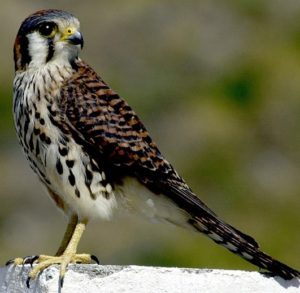
The bad news? The predator is also prey for larger hawks, crows, dogs and cats. The good news? This keeps the Kestrel on guard and alert. (Photo courtesy Linda Simmons)
Even though it’s small, the Kestrel is used in sport falconry, sometimes as the beginner bird. If captive for sport, the falconer must be mindful of the Kestrel’s weight as even a small weight loss (we’re talking ounces!) could be fatal. 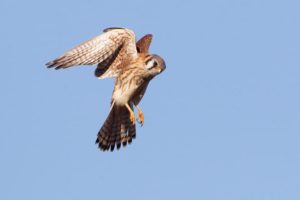
During courting, the pair often gifts each other with food. The Kestrel mates for life and often returns to the same nesting site year after year.
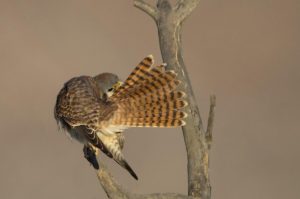
By the way, the male chooses the nesting site, but the female has the final word before they move in. Umm…that sounds familiar, yes? (These two photos courtesy Chris Mayne)
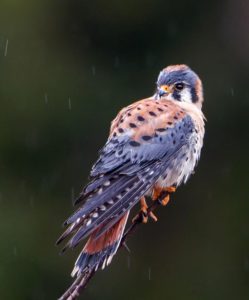 Finally, all of us have a bad feather day now and again. But not everyone looks as darn cute as a Kestrel!! (Photo courtesy Gerald Friesen)
Finally, all of us have a bad feather day now and again. But not everyone looks as darn cute as a Kestrel!! (Photo courtesy Gerald Friesen)
Hope you enjoyed this mini-lesson and that I’ve piqued your interest in reading “The Falcon Finds His Mate.”
One more “shout out” to these awesome photographers for permission to use their photos:
Gerald Friesen
Linda Simmons (Thanks to Chris, too!)
Chris Mayne
D. Allen Martin
My references if you’d like to know more:
https://www.beautyofbirds.com/americankestrels.html
https://www.allaboutbirds.org/guide/American_Kestrel/id
